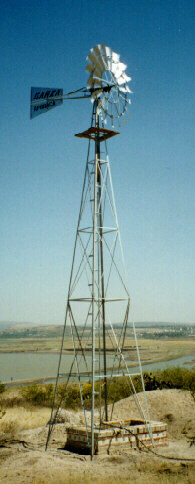| |
|
Propellers
The
use of propellers for extracting power from the wind provided
early civilizations with an important alternative to human or animal based stationary
power sources. The photograph shows a windmill of the type that opened
up the western plains of the United States by providing a reliable source
of well water for cattle farming.
By providing power to a propeller it
can impart motion to the air and can therefore couple human power output to
provide propulsion for an airplane. For boats, a propeller used for propulsion
can either interact with the water or the air through which the boat is moving.
Both modes have been used with the air propeller being favored for high
speed record attempts in still water, and the water propeller finding favor
for sea going boats.
The action of a propeller is that of a rotating
wing where the lift provided by the wing is the desired thrust for propulsion.
The blades also have an associated drag which reduces the overall efficiency
of power transfer from the human power source into useful thrust. For human
powered systems the efficiency must be as high as possible and the design
of the propeller airfoil is crucial to achieving sustained flight or long distance
boat travel. |
|
|
|
|
|
|
|
|

